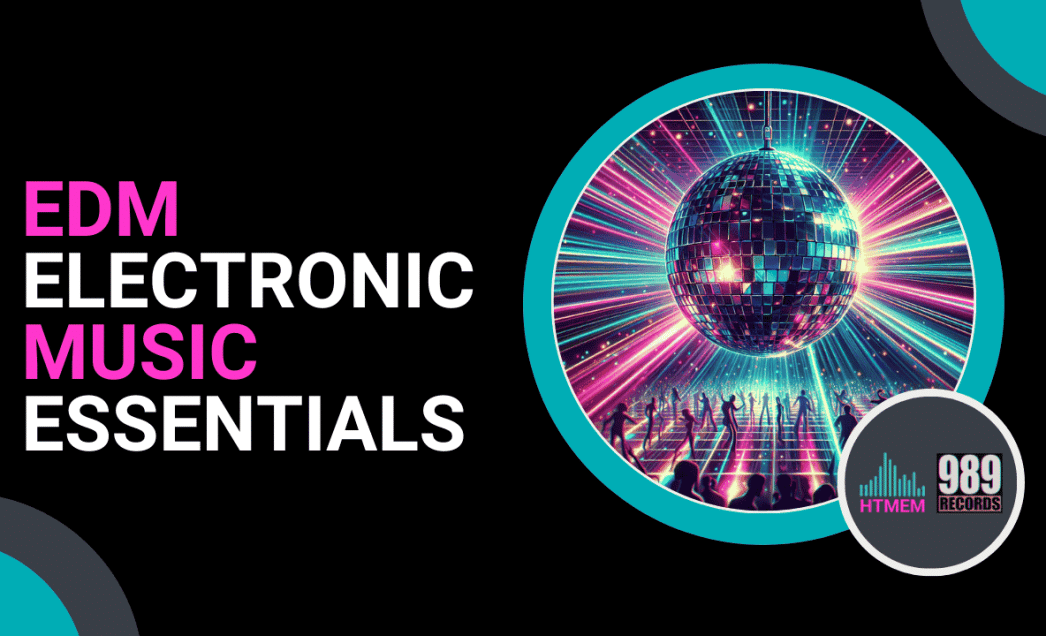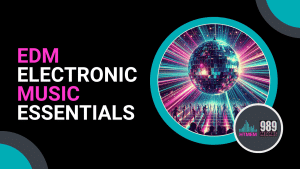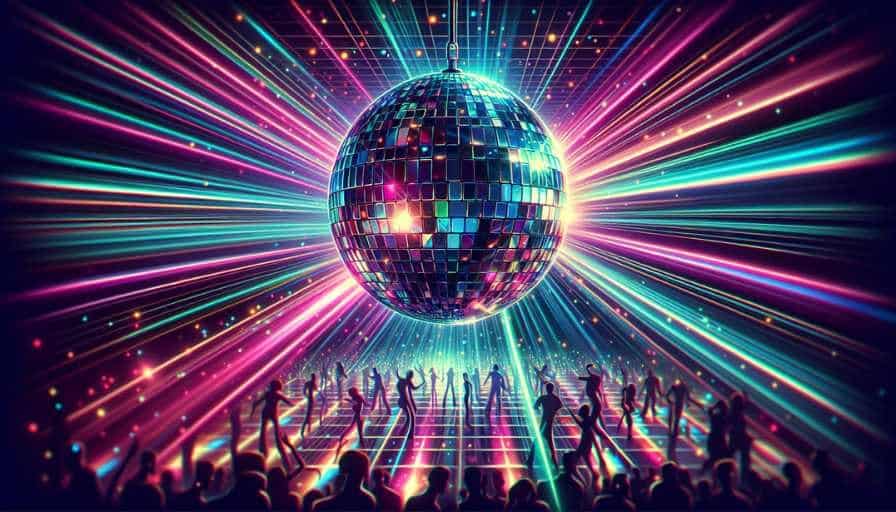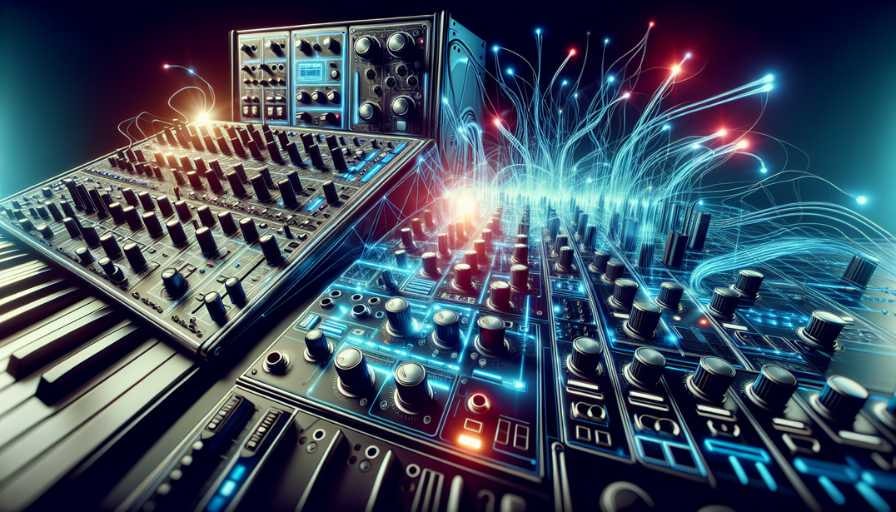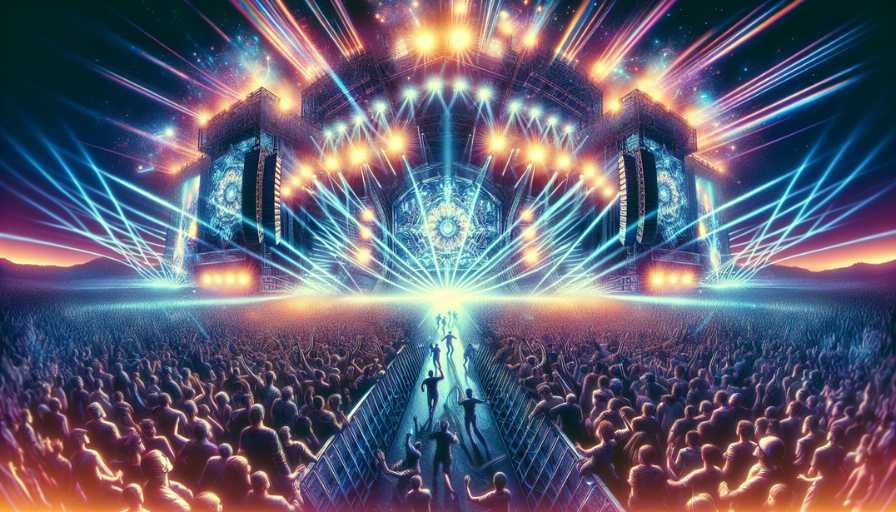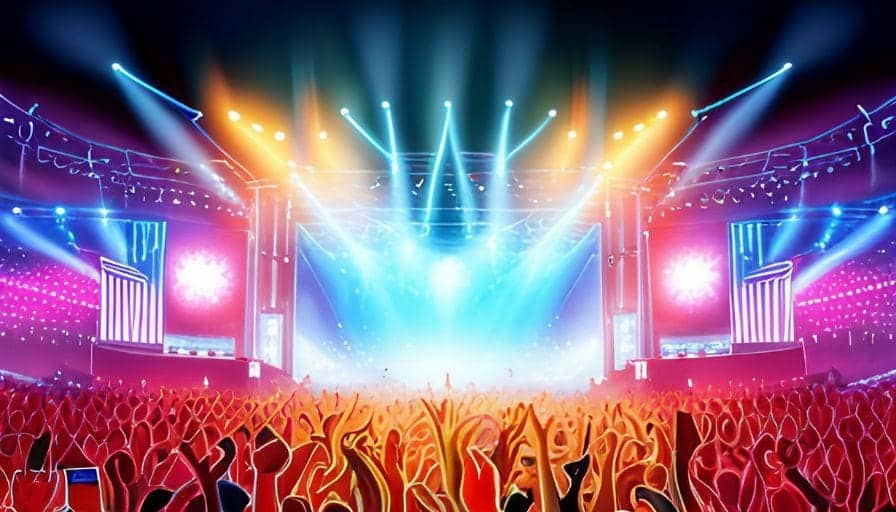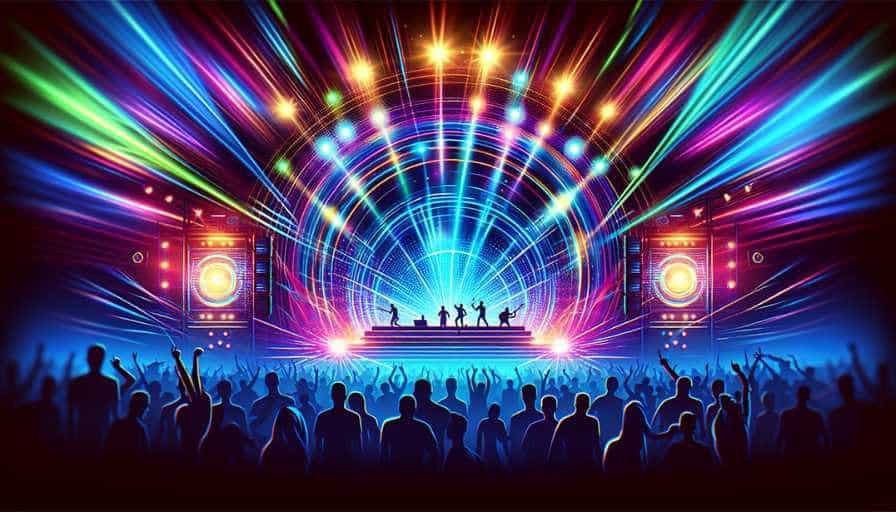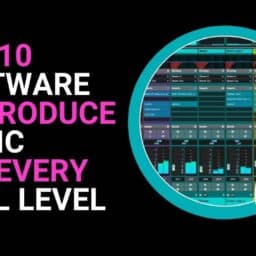EDM, or Electronic Dance Music, is a vibrant part of the electronic dance music culture that spans a spectrum of sounds, captivating music lovers worldwide. From pulsing beats to synthesized harmonies, this genre is synonymous with the energy of the night. Primarily produced for the social function of dancing all night, EDM thrives in settings that celebrate movement and rhythm. Its distinct styles include genres like house, techno, trance, and dubstep, appealing to a wide audience of listeners. This guide uncovers the essence of EDM electronic music, introducing you to its rich history, defining elements, and how it’s woven into the fabric of contemporary music… all without overwhelming detail 😉.
Key Takeaways
- EDM originated from the disco era of the 1970s in New York, evolving into house and techno music thanks to innovators like Frankie Knuckles and alongside influential groups such as Swedish House Mafia, with artists including Giorgio Moroder and Kraftwerk paving its global spread.
- The production of EDM relies on technical skill and the creative use of equipment such as synthesizers, drum machines, and digital audio workstations, with revolutionary tools like MIDI technology shaping its sound design and methodologies.
- Ghost producers are often hired to produce music for other DJs and artists who release it under their names.
- The typical tempo of most EDM tracks ranges from 129 to 150 beats per minute, promoting energetic danceability.
- EDM comprises various genres, each with unique characteristics, exemplified by iconic electronic music festivals and events like Tomorrowland and Ultra Music Festival, highlighting its influence on mainstream pop through collaborations and chart success while also being affected by technological advances and cultural shifts.
What is Electronic Dance Music?
Electronic dance music (EDM) is a broad range of percussive electronic music genres originally crafted for nightclubs, raves, and festivals. Characterized by deliberately inorganic sounds and timbres, EDM often utilizes early-1980s gear or samples from previous recordings to create its unique soundscapes. While live instrumentation and singing can feature in EDM tracks, they typically serve as a garnish rather than the main dish. The primary focus of EDM is to create music that encourages dancing all night, with a strong emphasis on rhythm and beats. This genre of electronic music has evolved to include various styles, each contributing to the vibrant and dynamic world of dance music.
Exploring the Roots of EDM: From Disco to Dance Revolution
The seeds of EDM were sown in the disco music of the early 1970s. However, its origins can be traced back even further to Jamaica in the 1960s with the development of dub music. Drum and bass, another influential subgenre, developed within the rave scene in the early 1990s, showcasing the genre’s adaptability and evolution. The 1990s saw the rave scene grow into a global phenomenon characterized by large underground parties. Dubstep, a later addition to the EDM family, originated in South London in the late 1990s, further diversifying the genre.
Hitting the streets of New York, artists like Donna Summer and George McCrae left an indelible mark on the electronic music scene with tracks like ‘I Feel Love’ and ‘Rock Your Baby,’ respectively, laying the groundwork for the EDM scene. However, it wasn’t all smooth sailing for disco music. In 1979, the ‘Disco Sucks’ movement and events like ‘Disco Demolition Night’ marked the decline of disco, paving the way for its evolution into house and techno music.
The transformation was led by DJs like Frankie Knuckles, who, along with other artists from Chicago’s underground clubs, reimagined disco using innovative mixing techniques, giving birth to house music. House music was born in the early 1980s in Chicago under the guidance of DJ Frankie Knuckles. At the same time, techno music emerged from the blend of German electro-pop and American house music, forming a new subgenre in the EDM landscape during the 1970s and 1980s. Techno music emerged around the same time as house music in Detroit, with pioneers like Juan Atkins and Derrick May.
This period also saw the rise of influential groups like Swedish House Mafia, who contributed to the growing popularity of house and techno music.
Many early pioneers played crucial roles in the evolution of electronic dance music. Noteworthy among them are Giorgio Moroder and Kraftwerk, whose contributions helped the genre spread across different parts of the globe. Their influence can still be felt today as EDM continues to dominate charts and dance floors worldwide.
The Art of EDM Production: Key Elements and Techniques
The art of EDM production is a blend of creativity, technical skills, and the right equipment. Electronic music production allows complete creative control over every second of a song.
Primarily made on a computer using a Digital Audio Workstation (DAW), producers employ equipment like samplers, synthesizers, and effects units to create their unique sounds and beats.
To produce electronic dance music successfully, it’s vital to have access to high-quality samples, plugins, and education. Sampling from previous recordings is a common technique in EDM production, allowing producers to create new tracks by reimagining existing sounds. Many bedroom producers, using laptops or home studios with low-cost software and equipment, have contributed significantly to the genre’s growth and innovation.
Check Our Courses Now!
Synthesizers and Drum Machines
Synthesizers and drum machines are the heart and soul of EDM production, serving as the primary electronic music instruments.
They provide the diverse range of sounds we hear in EDM tracks, from deep basses to ethereal tones. The sounds are shaped using filters, envelopes, and built-in effects such as reverb and delay, enhancing the texture of the music. EDM often incorporates deliberately inorganic sounds and timbres, produced by electronic equipment such as drum machines, which contribute to its distinctive character.
Synthesizers come in two main types: analog and digital. Analog Synthesizers use voltage-controlled filters (VCFs) and oscillators (VCOs, LFOs), while Digital Synthesizers employ digital signal processing (DSP) to generate sounds.
Electronic drum machines, like the Roland TR-808, TR-909, or TR-707, provide the distinctive beats that are integral to the sound of house music. In the past, these beats were often recorded on reel to reel tape, which added a unique warmth and character to the music.
Techno music production prominently features electronic instruments like synthesizers and drum machines, enhancing its unique sound. These instruments are just a few examples of the critical tools used by techno producers in EDM production, shaping the genre as we know it today.
MIDI Controllers and Software
The 1980s brought a revolution in electronic music production with the introduction of MIDI technology. This groundbreaking innovation revolutionized the communication between electronic instruments, significantly shaping production methods and sound design in electronic dance music. DJs primarily play EDM in nightclubs, mixing various tracks to create a continuous dance experience that keeps the energy alive. MIDI controllers and electronic music software programs for synthesizers and digital audio workstations have become essential tools for modern EDM production, enabling unprecedented creative possibilities.
Getting Started with EDM Production
Embarking on the journey of EDM production can be both exciting and creatively fulfilling. To get started, you’ll need a few essential pieces of equipment: a computer, a digital audio workstation (DAW), and a pair of quality headphones. Begin by familiarizing yourself with the basics of music production, such as creating beats and melodies and using effects and plugins to enhance your sound. There are numerous online resources available to help you learn, including YouTube tutorials, online courses, and music production blogs. As you progress, you’ll develop your unique style and sound, contributing to the ever-evolving landscape of electronic dance music.
Decoding Popular EDM Genres: Characteristics and Examples
House music morphed into a global sensation by the mid-1980s, spawning new electronic music genres and making its mark on international music scenes. This progression of EDM into a distinct genre is evidenced by the popularity of various subgenres like progressive house and techno throughout time.
Each subgenre of EDM has its unique characteristics. Trance music developed from the rave scene in the UK in the late 1980s and gained popularity in Germany during the early 1990s. Acid house developed as a notable style in the United Kingdom in 1988, further diversifying the EDM landscape.
House Music, for instance, is distinguished by a consistent 4/4 beat and originated in Chicago. Techno music, on the other hand, which began in Detroit, is known for its repetitive instrumental music and often features a 4/4 beat. Deep house, a subgenre of house music, features a lower tempo and a more soulful feel compared to regular house, offering a more relaxed yet immersive listening experience.
Other popular genres within electronic dance music include:
- Ambient Music
- Big Room
- Electro House
- Trap, which originated from techno, dub, and Southern hip hop in the late 2000s
- Dubstep
- Hardstyle, which combines elements from techno and hard trance, offers a high-energy and intense listening experience.
Each genre has its distinct sound and structure. These various styles and expressions of EDM weave together to create a rich and dynamic mosaic, offering something different for every music lover.
House Music
Originating from ‘The Warehouse’ nightclub in Chicago, House music gained immense popularity, thereby cementing its identity in electronic music history. Originating from the Black queer community in Chicago, house music is characterized by a four-on-the-floor beat with tempos usually between 120 and 130 beats per minute.
The structure of a typical house music track includes:
- An intro
- Multiple verses
- A Chorus
- A Midsection
- An Outro
The dance sound incorporates elements of disco, post-disco, and synth-pop, greatly influenced by the early work of DJs and producers.
Key figures in the development of house music and early hip-hop include:
- Frankie Knuckles
- Ron Hardy
- The Hot Mix 5
- Afrika Bambaataa
- Jesse Saunders
- Vince Lawrence
- J.M. Silk
Their work laid the foundation for the genre, creating a platform for future artists to build upon.
Techno Music
Detroit is credited as the birthplace of techno music, with foundational contributions from the Belleville Three: Juan Atkins, Derrick May, and Kevin Saunderson. Characterized by its repetitive, dance-friendly beats, Techno music typically falls within a tempo range of 120 to 150 BPM and follows a 4/4 time signature.
Live techno performances often exhibit variety as tracks are composed through looping basslines and drumbeats, allowing for real-time manipulation and improvisation. This adaptability and spontaneity add a unique flavor to techno music, making each performance a unique experience.
Juan Atkins is noted as a formative figure in the launch and development of the techno genre, with other key electronic music pioneers including Derrick May and Kevin Saunderson. Their innovative work has inspired countless artists and continues to shape the genre.
Trance Music
Known for its repeating melodic phrases and tension-building structure, Trance music is a captivating subgenre of EDM, one of the many electronic music subgenres. It often features a mid-song peak, a melodic breakdown, and then a buildup to a second peak. This structure creates a sense of journey or progression within the music, making it a favorite among many EDM enthusiasts.
The genre’s hypnotic sound, coupled with its unique structure, transports listeners into a trance-like state, hence the name.
From its roots in the underground music scene to its prominence in major music festivals, trance music continues to captivate listeners worldwide with its distinctive sound.
The EDM Industry: Distribution and Promotion
The EDM industry is a rapidly growing and evolving market, with new artists and producers emerging constantly. To succeed in this competitive field, it’s crucial to understand the intricacies of distribution and promotion. Getting your music heard by the right people, such as DJs, promoters, and record labels, is essential. Building a strong online presence through a website and social media profiles can help you connect with fans and promote your music effectively. Various distribution channels are available for EDM music, including online music stores like Beatport and iTunes, as well as streaming services like Spotify and Apple Music. By leveraging these platforms, you can reach a wider audience and establish your place in the EDM industry.
The EDM Scene: Iconic Festivals and Events
The evolution of EDM brought about transformations in the venues where it was played, leading to grand electronic music events worldwide. Today, EDM is celebrated in grand festivals and events worldwide. Major EDM festivals represent more than 20% of their lineups. Some of the notable EDM festivals include:
- Tomorrowland in Belgium is the largest EDM festival globally, attracting an international audience with its magical experience. Since its first edition in 2005, Tomorrowland has been one of the most magically decorated festivals.
- Ultra Music Festival in Miami: celebrated for its high-energy performances and advanced production.
- Electric Daisy Carnival in Las Vegas is known for its grand scale and lavish presentation.
- Amsterdam Dance Event, which features more than 2000 DJs across 450 events, showcasing the genre’s global reach and influence.
These festivals showcase the best of EDM and provide an unforgettable experience for music lovers.
These festivals are more than just music events; they are cultural phenomena that celebrate the EDM lifestyle. Iconic festivals like Ultra Music Festival and Electric Daisy Carnival have achieved enormous commercial success, drawing hundreds of thousands of attendees and hosting international editions in countries like Japan, Croatia, and South Africa.
Other notable EDM festivals include Creamfields in the UK and India’s Sunburn Festival, celebrated for their impressive line-ups, and indicative of the genre’s popularity in both Europe and Asia. Creamfields is traditionally held during the August Bank Holiday weekend in the U.K., making it a staple event for EDM enthusiasts in the region. These events showcase the vibrant diversity and global appeal of the EDM genre, drawing fans from all corners of the world.
Ultra Music Festival
Born in Miami in 1999, Ultra Music Festival has grown to become one of the world’s largest and most famous EDM festivals. Ultra Music Festival started as a party at the Winter Music Conference in Miami in 1999. Ultra’s flagship event in Miami serves as the culmination of EDM culture, annually aligning with the Winter Music Conference.
Ultra Music Festival has significantly influenced the spread of electronic music, fostering the EDM culture across the globe. It’s not uncommon for top-tier DJs and music producers to choose Ultra as the platform to debut their new music, enhancing its reputation as a cradle of fresh electronic sounds.
Reflecting its international reach, Ultra has successfully branched out to numerous countries, adapting the festival experience to diverse cultural contexts.
Today, Ultra Music Festival is a name synonymous with the best in EDM, attracting fans from around the globe with its high-energy performances and star-studded line-ups, epitomizing electronic music festival culture.
Electric Daisy Carnival
One of the biggest electronic music festivals globally, the Electric Daisy Carnival (EDC), started in 1997 in Southern California. Originally a one-day event, EDC has grown into an international festival spreading over three days and attracts hundreds of thousands of attendees.
EDC is known for:
- its elaborate stage designs, offering an immersive sensory experience
- being held in Las Vegas, a destination known for its entertainment value
- carnival rides, art installations, and other interactive experiences alongside the music
Electric Daisy Carnival (EDC) became a two-day event in 2009 and a three-day event in 2011, reflecting its growing popularity and scale.
- its elaborate stage designs, offering an immersive sensory experience
- being held in Las Vegas, a destination known for its entertainment value
- carnival rides, art installations, and other interactive experiences alongside the music
The festival features a lineup that spans various subgenres of electronic music, showcasing well-known headliners and emerging artists, offering a unique electronic music festival experience. EDC prides itself on uniting people through music with performances that emphasize the communal aspects of rave culture.
EDM’s Influence on Mainstream Pop Music
During the 90s, as house music gained popularity, the influence of electronic music started blending with mainstream music.
Pop icons like Madonna and Janet Jackson embraced the genre, signaling the onset of EDM’s influence on pop music. As EDM musicians such as Tiesto, Daft Punk, and David Guetta gained international acclaim and prominence in the early 2000s, the influence of EDM on mainstream pop music grew even more apparent.
Many mainstream pop musicians today, such as Ellie Goulding, Justin Bieber, Coldplay, and Katy Perry, often infuse elements of EDM into their music. EDM has seen a significant crossover with mainstream pop through examples like ‘Wake Me Up’ by Avicii, ‘Lean On’ by Major Lazer & DJ Snake, and collaboration hits such as ‘Starboy’ and ‘I Feel It Coming’ by Daft Punk with The Weeknd.
EDM producers, including David Guetta, Zedd, and Calvin Harris, have achieved significant chart success with their pop-infused electronic tracks, while cross-genre collaborations, like Martin Garrix featuring Usher in ‘Don’t Look Down’, further indicate EDM’s influence on pop music. The blurring of lines between EDM and pop music is a testament to EDM’s versatility and its growing influence in the global music scene.
The Impact of Technology on EDM Evolution of EDM
Technological advancements in electronic music technology have played a significant role in shaping EDM. Some key advancements include:
- Iconic drum machines like the Roland TR-808, which were instrumental in the development of the genre
- Advances in CDs, DVDs, and digital formats allowed for easier distribution and accessibility of EDM music
- The evolution of DAWs, like Steinberg Cubase, and other DAWs, revolutionized the sound and production of EDM
These advancements have greatly influenced the evolution and popularity of EDM.
Since the late 1990s, the evolution of EDM production has been heavily influenced by the surge in usage of software, digital audio workstations, and software synthesizers, controlled with MIDI controllers. In the genre’s early days, electronic musical instruments were predominantly used for EDM production. This shift from analog to digital has revolutionized the way producers create music, allowing for more complex sounds and arrangements.
The distribution and consumption of EDM have also been greatly influenced by digital platforms. Some examples include:
- Beatport, the leading electronic music store, signals the importance of digital platforms in the industry
- Streaming platforms like Spotify and SoundCloud allow users to discover and listen to EDM tracks easily
- Social media platforms like Instagram and TikTok have played a role in promoting EDM artists and their music
Furthermore, the marketing and commercialization of EDM were propelled by terms like ‘EDM’ becoming popular around 2010-2011, as genres like Big Room and Trap gained prominence. The term ‘EDM’ gained popularity in the United States in the early 2010s as a way to market dance music. The term EDM was popularized as a marketing term to distinguish contemporary electronic music made for dance floors, further solidifying its identity in the global music scene.
The Future of EDM
The future of EDM is both exciting and uncertain, with new technologies and trends continually emerging. One of the most significant trends in EDM today is the rise of live streaming and virtual events, allowing artists to connect with fans in innovative ways. Additionally, the increasing popularity of underground and niche genres, such as techno and ambient music, offers a fresh alternative to more commercial EDM styles. As the EDM industry continues to evolve, we can expect to see even more groundbreaking developments and trends shaping the future of electronic dance music. Whether through technological advancements or the exploration of new musical styles, the world of EDM remains dynamic and ever-changing.
The EDM Community: Culture, Lifestyle, and Controversies
Much like music, the electronic music culture is incredibly diverse. It values artifacts like ‘kandi’ bracelets as symbols indicating authenticity and insider status. However, the community is not without its hierarchical views, with ‘EDM Bros’ often being looked down upon by those who value the music’s history over the party environment.
The ‘PLUR’ philosophy of Peace, Love, Unity, and Respect is a cornerstone of the rave culture, promoting a positive and inclusive atmosphere. EDM events are characterized by their inclusivity, with attendees finding solace in self-expression free from race, gender, or sexual orientation-based judgments. The original spirit of rave culture is maintained through inclusivity and individuality, demonstrated by the diverse costumes seen at festivals.
Even with its vibrant culture and inclusive spirit, the EDM scene has been marred by controversies around recreational drug use. Drugs like MDMA, LSD, and ketamine are prevalent among rave enthusiasts, aimed at augmenting sensory perception and social bonding.
Major electronic music festivals like Electric Daisy Carnival have been affected by drug-related incidents, highlighting concerns surrounding rave events. The severity of drug-related issues within EDM culture has led to measures such as the temporary ban on electronic music events in Buenos Aires after the Time Warp Festival incident.
Summary
From its roots in the disco era to its influence on mainstream pop, electronic music evolution has come a long way. By the late 2010s, however, EDM began to plateau in terms of mainstream popularity due to changing musical landscapes, reflecting the genre’s dynamic and ever-evolving nature.
The genre has evolved and diversified, giving rise to numerous subgenres, each with its unique sound and characteristics. The global EDM scene, brought to life through iconic festivals and events, is a testament to the genre’s enduring appeal and global influence.
Despite the controversies and challenges, the EDM community remains united by a shared love for the music. Embracing inclusivity and individuality, the community continues to thrive and evolve, much like the music itself.
As we look to the future, one thing is for sure – the beat goes on, and so does the vibrant world of EDM. 🔥
Frequently Asked Questions
What is the origin of EDM?
The origin of EDM can be traced back to the disco music of the early 1970s, leading to the evolution of house and techno music in electronic music history.
How is EDM produced?
EDM is primarily produced using a computer and a digital audio workstation, employing various electronic music production techniques. Producers use equipment like samplers, synthesizers, and effects units to create unique sounds and beats. Electronic dance music is generally composed and produced in a recording studio with specialized equipment such as samplers and synthesizers. Most EDM music is created using software synthesizers and effects units controlled with a MIDI controller.
What are some popular EDM genres?
Popular EDM genres include house, techno, and trance, each with its own unique characteristics and electronic music styles.
How have technological advancements influenced EDM?
Technological advancements have revolutionized EDM production through electronic music innovation, including the use of software, digital audio workstations, and MIDI controllers.
What is the EDM community like?
The electronic music scene is known for its diversity, inclusivity, and embrace of the ‘PLUR’ philosophy, but it has also faced controversies related to recreational drug use. It’s a community that values peace, love, unity, and respect.
Suggested Readings
The Gear Guide for Every EDM Musician
How Many Keys Are in a Piano
Exploring Bit Depth: How It Shapes Digital Audio Quality
Practice and enjoy!

